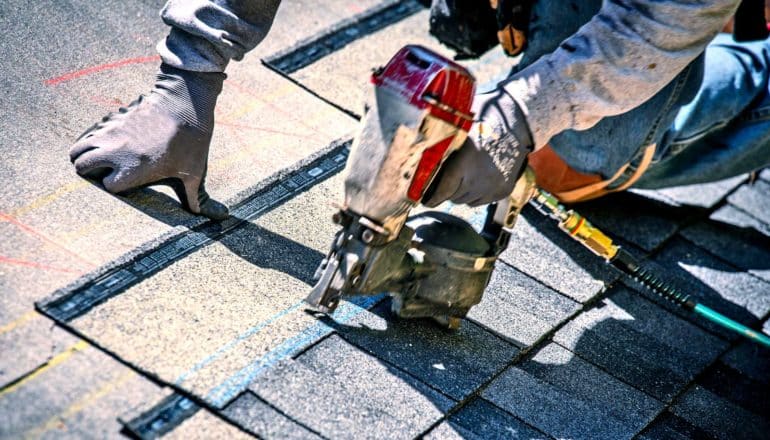
A new aerial vehicle called an “octocopter” can attach asphalt shingles to a roof without a human at the controls.
Engineers demonstrated that the drone can autonomously position a nail gun on a nailing point, place the nail, and then move on to the next point.
“For me, the biggest excitement of this work is in recognizing that autonomous, useful, physical interaction and construction tasks are possible with drones,” says Ella Atkins, a professor of aerospace engineering and robotics at the University of Michigan.

Is roofing a robot job?
Atkins says many consider tasks best suited to robotization “dull, dirty, and dangerous,” and robots like octocopter could offer a way to move the human workforce to cleaner, safer, and more interesting jobs.
Already, drones spare humans some high-stakes fall risks by inspecting bridges, wind turbines, and cell towers. The natural next step, Atkins says, is to upgrade from surveillance alone to performing physical tasks.
The problem of nailing down a shingle breaks down into several smaller problems—including telling the octocopter where the nails should go and triggering the nail gun.
Atkins’ team used a system of markers and stationary cameras to enable the octocopter to precisely locate itself in space and then to tell the octocopter where the nails should go.
To fire the nail gun, they first measured the force needed to compress the point of the nail gun, a necessary task before a nail will deploy. Then, they wrote software that to enable the octocopter to apply that force.
The off-the-shelf version of the electric nail gun requires the compressing of a trigger as well, but the team turned that into a virtual switch which activated when the octocopter was in position to place a nail.
Slow but learning
For now, the drone doesn’t move as fast as human roofers.
“Initially, we tried using faster approach speeds to minimize nailing time,” says Matthew Romano, a robotics PhD student and first author of a paper submitted to the International Conference on Robotics and Automation.
“However, for those attempts, the nail gun tip often bounced off the roof, which meant it either wouldn’t trigger or it would trigger in the wrong place.”
“A novice roofer—who’s never climbed on a roof, who’s never used a nail gun—they start out slow. That learning process, the evolution from them being a complete novice to being successful, is something that we’ll need to see in this system as well,” Atkins says.
In addition to speed, the team identified other improvements needed for a practical system. First, a tether should power it, not a battery. Because both batteries and nail guns are heavy, the system can only run for a little more than 10 minutes at a time. A tether would allow it to run indefinitely. Also an air line running alongside the power cable could make the nail gun a more effective pneumatic model.
Finally, a system of cameras and markers is more complicated than a roofing drone would actually need. Shingles are marked with a shiny adhesive strip, in addition to the color difference between the exposed surface and the portion that lies beneath the next layer of shingles.
“It would be pretty easy to have a camera system mounted on the octocopter that understands both the orientation of the shingle and its position,” Atkins says.
The National Science Foundation funded the work.
Source: University of Michigan
The post Watch a roofing drone fire its nail gun appeared first on Futurity.
from Futurity https://ift.tt/2lEu2OA
No comments:
Post a Comment